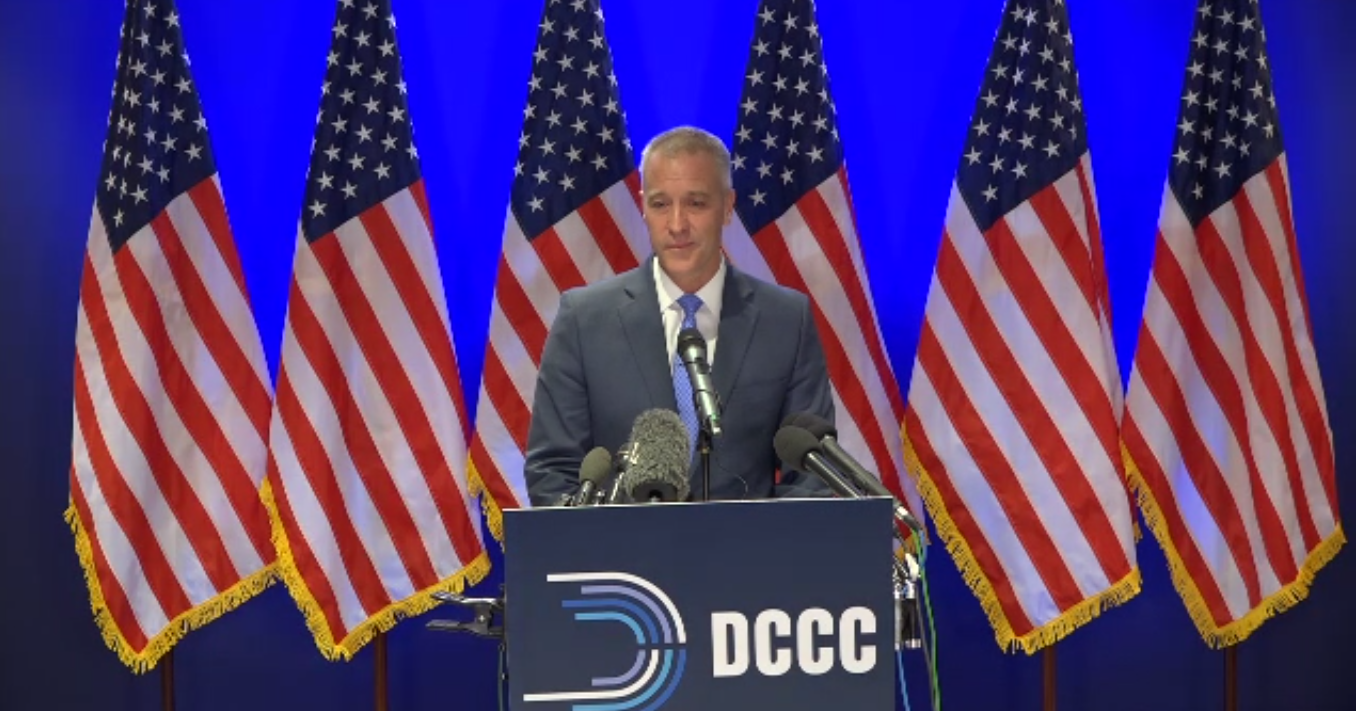
Congressman-elect Mike Lawler addresses a crowd of Rockland County Republicans on election night.
The 2022 midterm elections, held this Tuesday, saw New York’s Hudson Valley become the frontline in what observers are calling a battleground state. In districts, now redrawn, that went to President Biden in 2020, Republicans have picked up two seats in Congress, and deposed DCCC Chair Sean Patrick Maloney, D-Cold Spring, in the process.
The districts, NY-17, NY-18 and NY-19, cover the Hudson Valley from Westchester County all the way to the edge of the capitol region. There was something of a shuffle this summer as a result of court appointed Special Master Jonathan Cervas’ redrawn district map, ordered as a result of Democratic gerrymandering in the State Legislature.
Rep. Maloney, who declared he would run where he lived, chose to move down a district from NY-18 to NY-17 after his home in Cold Springs fell under its new borders. As this played out, Rep. Pat Ryan, D-Gardiner, formerly the Ulster County Executive, was running in a special election against Dutchess County Executive Marcus Molinaro, R-Red Hook, to complete Lieutenant Governor Antonio Delgado’s term in the old NY-19. Ryan ended up winning on the back of a campaign that emphasized the importance of protecting women’s rights, following the Dobbs decision in the Supreme Court.
Josh Riley, D-Ithaca, returned to New York in 2021 after practicing law in Washington D.C. for several years and decided to run in the race for the redrawn NY-19. His opponent was non other than Molinaro, who chose to run against him after Assemblyman Colin Schmitt, R-New Windsor, chose to run against Pat Ryan in NY-18.
Maloney himself would also be running against a member of the Legislature, Assemblyman Mike Lawler, R-Pearl River. Lawler, a former campaign consultant, lead in internal polls through much of the campaign before winning Tuesday night.
Lawler spoke prophetically weeks earlier about the outcome of the race. Referencing the work of Democrats both in New York and D.C., Lawler said, “They control everything in Washington, Albany, and New York City, leaving voters with but one choice: either vote for them and continue these policies or vote against them. And I think on Election Day, you’re going to see, across the country, voters are going to reject these policies en masse.”
Lawler led from the moment results were released, Westchester County’s returns being the only factor leaving his victory in question. After taking Putnam and Dutchess County’s handily, he also snagged Rockland County by ten points. Westchester, home to population centers like Yonkers and Mount Vernon, ultimately proved Maloney’s undoing as he won the county by 9,000 votes but ended the night over 13,000 votes short.
Lawler sent home his election party goers, gathered at the Pearl River Hilton, in the wee hours Wednesday with the race still too close to be called. “We are not yet ready to declare victory but with just a few more votes to be counted we are poised to make history,” said Lawler to a cheering crowd, before adding that their victory would mean the removal of Sean Patrick Maloney as DCCC chair and the end of Nancy Pelosi’s reign as speaker of the house.
Lawler would end up winning 51 percent to 46 percent.
Maloney, who had been in D.C. election night, publicly conceded to his supporters later that day from the nation’s capital. “I don’t think the American people have given up on democracy and I think with all the headwinds and all of the damage from the pandemic and the Trump years, there’s still a beating heart to American democracy and I think you saw it last night,” Maloney said, getting choked up at times.

Photo by Austin Jefferson.
“I don’t like to lose but my opponent won this race, and he won it fair and square and that means something.”
Josh Riley went into Tuesday five points ahead of Molinaro in the polls. This didn’t translate to election results in a race where Riley lost 48 percent to Molinaro’s 50 percent.
Both candidates ran on similar platforms of improving the economy for the upstate region, increasing mental health and drug resources for citizens and increasing funding for law enforcement. Each candidate also painted the other as extreme with call backs to abortion rights issues and cashless bail.
Riley, after leading earlier in the night, lost ground all over the district. Places like Greene and Sullivan Counties cost him roughly eight thousand votes, for example. Sullivan County, incidentally, is where former President Bill Clinton appeared for a get out the vote rally in late October.
“I’m pleading with you, go out there do whatever you can in these last few days. Tell people not to shoot themselves in the foot. I could go through all these issues,” said Clinton at the event in Hurleyville, New York.

Photo by Austin Jefferson.
Riley left the outcome up in the air on election night when he refused to admit defeat, even after Molinaro had given a victory speech. In a statement released a little after midnight he said, “Our understanding from conversations with Board of Election officials is that we’re down, but we’re not out. We understand that there are an unknown number of absentee ballots to be counted and affidavit ballots to be processed. We want to be sure every voice is heard, and we are going to do that.”
Late Wednesday afternoon, after the several thousand votes his campaign had hoped would go his way never surfaced, he acknowledged defeat in a post he shared with Facebook followers. “I’ve called Marc Molinaro to congratulate him on his hard-fought victory, to wish him all the best in Congress, and to thank his family for the sacrifices they’ve made in the spirit of public service. I appreciate Marc’s stated commitment to opposing a national abortion ban, improving funding for mental health services, and creating good jobs in upstate New York.”
Molinaro who has been running for elected offices since the age of 18, will now represent this sprawling district of semi-rural counties and leave his post as Dutchess County Executive. He said, “Last night we sent a message. Our district, and our country, isn’t red or blue. We are all Americans who want their government to work – to deliver on the promise of life, liberty & the pursuit of happiness.”
Hudson Valley Democrats were able to count one congressional victory among their ranks. Pat Ryan beat Colin Schmitt in an extremely close race. When Schmitt finally conceded, in a race where ads called Ryan “dangerously liberal”, a 2,000 vote margin separated them.
“We won with every ounce of courage and integrity and humanity and moral fiber that we have in our bodies, to make our democracy better, to heal it,’ said Ryan when giving his victory speech.

Courtesy of Pat Ryan via Facebook.
The mood was different in the Schmitt camp with some leaving his New Windsor election party bereft at the results. “There goes my night,” said a woman rushing out the doors at a little after 2 a.m., by which point all precincts had reported.
In a concession statement Schmitt said, “After a hard-fought campaign the people of our district made their choice and I respect their decision. I wish the best for Pat Ryan and hope he will do great things for Hudson Valley families.”
Ryan ran for the redrawn version of the 18th District after serving the past three months as the representative for the old NY-19. He narrowly lost in Orange County, an area including Newburgh and Middletown, with Schmitt taking the County by 8 percentage points and about 10,000 votes.
He managed to recover in other parts of the district, finishing nearly 9,000 votes ahead of Schmitt in Ulster County and another 3,000 votes ahead in Dutchess County. He ended the night with a vote share of 49.37 percent to Schmitt’s 48.56 percent in the race.
After an eventful campaign and election night, the Hudson Valley will send two new representatives to Congress, bid farewell to a decade-long public servant to the region and see Pat Ryan extend his time in the House. It took until the next afternoon to see firm concessions from all the races, but the Hudson Valley has decided it’s voices in D.C. for the next two years.




